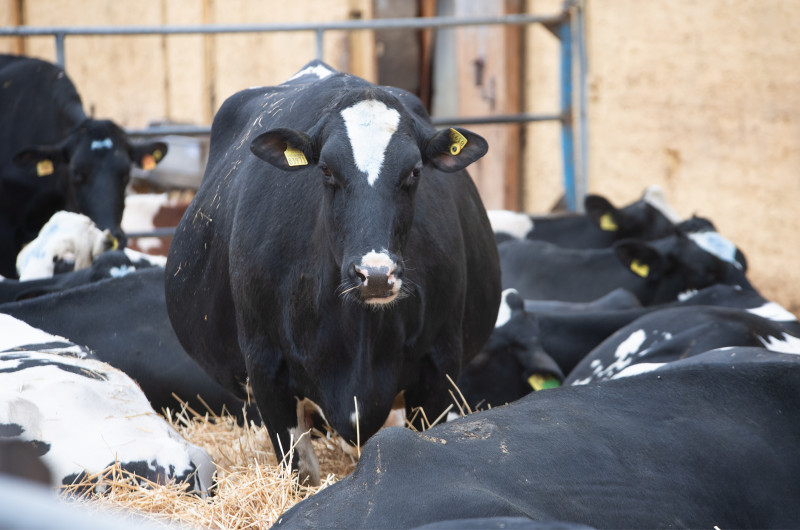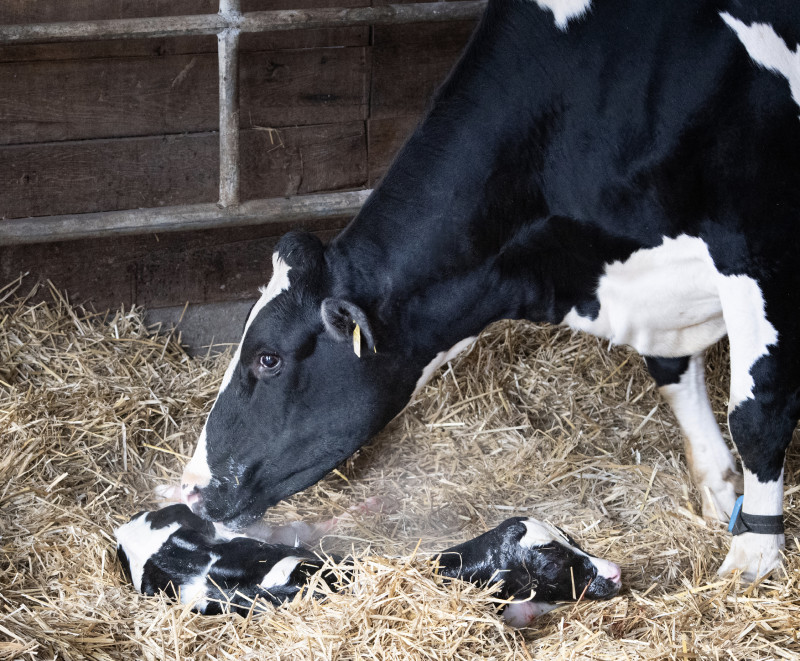
The time around calving marks an important period in the life of a cow and remains a big challenge on dairy farms. The last 40 days before and the first 60 days after calving are a significant factor in determining both the financial success and the average lifespan of our cows. With good animal observation and good herd and feeding management, the number of clinical and subclinical diseases can be drastically reduced.
JACQUES BERNARD christine massfeller
Anyone who has ever worked with dairy knows the risks and perils associated with calving. Milk fever, metritis, mastitis, ketosis and acidosis. The difficult thing is that diseases rarely occur individually, but in many cases lay the groundwork for the next sickness. Different studies assume that 40-70% of all Holsteins are affected by clinical and subclinical diseases around the time of calving. It is particularly difficult to estimate the number of subclinical diseases, as compared to clinical cases they cannot be easily measured and as such they are not treated. According to experts indicate that per clinical case, five to ten subclinical cases should be assumed. That is why prophylaxis is worth gold.
HEALTHY ANIMALS
In practice, there are farms where the aforementioned problems have become a rarity. They have learned that it is much more expensive and time consuming to deal with sick animals than diligently implementing sophisticated herd and feeding management concepts. What often separates these farms from the others is that the basic tasks are carried out almost perfectly before pursuing more complex solutions. This begins with the dry-off, through switching pens and groups to the feeding of specific rations with high quality, hygienic feed components. It is easier and more economical to work with healthy animals, as in addition to higher yields, these animals also live longer. This is one aspect that is becoming more important for consumers, just like the use of medicines, particularly antibiotics. That is why many farms around the world have developed well-tested concepts and products to maximize animal health before and after calving and to avoid diseases.
BASICS
‘Dry matter intake, dry matter intake, dry matter intake!’ is the golden rule of Dr. Arnout Dekker, which he repeated several times during our discussion. Dekker is a veterinarian and feed expert in Europe for the company Phibro – Animal Health Corporation. ‘Sure, it is important to feed the right ration at the right time, but it is almost more important that dry matter intake is at a maximal level at every time point. Before and after calving, as a cow who eats a lot is healthy and happy to produce!’ Dekker continues. In practice is unfortunately most often the basics that aren’t given enough attention, which in turn limit animal welfare and production. A general topic, for example, is water intake. On many farms this is extremely limited, either through a lack of drinkers, limited water flow or lack of hygiene. Nonetheless, water is not only the most important, but also the cheapest feed component. Another practical example is that on many farms, too many animals change groups in the three weeks before calving, whereby each group or pen change slows feed intake and thereby limits profitability. Cows love routine and anyone who takes a closer look at the top herds will always see that there are as little changes as possible and overall, when change happens, they occur as gently as possible, both for group and ration changes.
NEEDS-BASED
At Phibro, they have been convinced for years that the transition diet should be calibrated to a DCAB (dietary cation-anion balance) of between -150 and -180 meq/kg DM, which research shows is the most effective method to prevent milk fever. It is important to rountinely check the pH value of the urine of the animals (goal: 5.5-6.0). To acidify the ration, the flavoured, anionic mineral supplement AniStart® is used to optimize the calcium metabolism three weeks before calving (more on calcium metabolism in HI 12/2020 and 06/2022). To achieve this, grass silages should be avoided or minimally included in the transition diets due to their high potassium content. As highly suitable components for a needs-based ration, Dekker names straw, corn silage, brewer’s grains and protein concentrate, for example 50% rapeseed meal (which contains important amino acids like methionine) and 50% soymeal. To support the immune system of the cow and calf, he also uses the OmniGen-AF product in his rations. This can be optimally used in fresh-cow diets or in complete rations for the entire milking herd, for example during times of heat stress.
FEED QUALITY
Lallemand Animal Nutrition specializes in microbial solutions for various fields, both in and out of agriculture. From Magniva silage inoculants which ensure a wide range of forages are fermented to quality silage to barn hygiene and enhancing manure, Lallemand Animal Nutrition offers a wide range of products to their customers. ‘Whether it’s for the dry cow ration of the milking cow ration, the most important aspect is always the quality and hygiene of the silage,’ explains Dr. Frank Kuechenmeister. Frank is part of the Technical silage team for Lallemand Animal Nutrition and is eager to share his and the company’s expertise directly to farmers and distributors. ‘Our key mission is to clarify and explain the ensiling process, as the topic often lacks sufficient attention to detail resulting in poor silage,’ says Frank. His primary goal is to harvest high-quality and clean silage, which is free of clostridia, yeast, and mould. To produce such a silage, the basics such as cutting height, packing and covering must be managed correctly, if these steps are carried out properly then, with the help of the Magniva silage range, a good silage can be made into a quality silage. In addition to improved digestibility and lower silage shrink, the Magniva Platinum range which boasts the gold standard L.buchneri strain 40788 which along with L.hilgardii 4785 helps reduce heating and spoilage and prevents the growth of toxins after the silo is opened, meaning a cleaner and more palatable silage is available to the cows.
TRANSITION
To obtain maximum feed efficiency from high-quality silage, Lallemand has selected a live Saccharomyces cerevisiae CNCM-1077 yeast, called Levucell SC. This live yeast promotes microbial balance in the rumen, enhancing fiber digestion. In addition, scientific studies have shown that it raises the pH value in the rumen, reducing the risk of acidosis. It is particularly important to monitor this evolution at the start of lactation, when the cow switches from a high-fiber, low-starch transition diet to a production ration containing less fiber and more starch”, explains Marie-Valentine Glica, Marketing Manager for the Ruminant Division. This is why Lallemand Animal Nutrition recommends incorporating Levucell SC to facilitate the change of diet. To optimize the well-being of cows at the start of lactation, many breeders use antioxidants in their rations, or distribute them via the milking robot where appropriate. In the case of particular problems, such as high somatic cell counts, they can also be used for the whole herd. Lallemand Animal Nutrition relies on a network of service companies, mineralists and feed manufacturers who incorporate these solutions according to customer requirements.

ENERGY
To supplement a needs-based feed mix, the company Techna Natual SAS offers different boluses based on alternative, natural products. One goal in this is primarily to even out the energy deficit in the fresh-cow phase to reduce the risk of metabolic diseases.
The Acetobol bolus supports liver function so that the cow can generate more glucose herself, which leads to high peak milk yield. The high milk yield is the most easily measured economic factor. However, the primary benefit is the generally improved health of the animal. The Acetobol energy bolus can be given from one week before to four days after calving. Countless trials on different farms showed a decrease of easily 50% in the number of ketosis incidents (measured by blood BHB levels). Additionally, there is an increase in milk production from days 1-42 of the lactation of 1.5kg per cow per day. To extend this benefit further, farms can give another Acetobol bolus between 30-40 days in milk. Less ketosis meansa visually more stable body condition, which also offers a fertility advantage.
‘Dry matter intake, dry matter intake, dry matter intake! That is the golden rule!’
REPRODUCTION
What comes after calving is determined before calving. For this, Techna Natual SAS has a production backed by many years of experience, Metrabol. This is a bolus the supports the physiological functions of the cow. ‘The key organ is the uterus and its recovery after calving this process should not be disturbed through vaginal exams,’ explains Gaspard Valdenaire, the Export Sales Manager at Techna Natual SAS. ‘Our primary goal is to have reestablished the estrous cycle about thirty days after calving. Studies have shown that we meet this goal with Metrabol in 80% of the cows. The costs of poor reproduction results are about €80 per cycle,’ Valdenaire continues. The bolus should be given immediately after calving so that the animal has the most benefit. The result is earlier and better heat detection as well as improved breeding success and this results in a shorter calving interval.
STANDARD OPERATING PROCEDURES
BoviSync is an innovative platform which aims to optimize the work routines on dairy farms and simultaneously collect and analyze valuable data. The collection of the data is done through an app that can be used right when working with an animal. At the same time, a wide range of information about the animal can be looked up. This minimizes unnecessary trips to the office and animal information is documented in a central location, which improves operational efficiency. ‘Another helpful aspect is the standardization of farm specific operating procedures. This ensures that different people execute tasks in the same way and every cow is handled in the same way according to her needs,’ explains Dr. Vanda Santos, veterinarian and International Account Manager at BoviSync. Regardless of how a farm defines and outlines their standard operating procedures, the app will send an alert three to four weeks before calving that a cow needs to be moved to the transition pen or indicates which cows need to be vaccinated. In addition to scheduled events, measurements like urine pH from individual animals can be documented so that better conclusions can be made for problems down the road.
MONITORING
When the cow has calved, new work protocols for the animal are released, for example an initial treatment immediately after calving or a fresh cow check in the days following. ‘For all problems that come up in the fresh cow check, like metritis or metabolic disease, farms can create individual treatment plans so that care can be administered quickly to help speed to the healing process,’ adds Santos. However, it is not only the standardization of operating procedures that drives the efficiency of farms, as a sophisticated monitoring system evaluated the collected data and gives insight about a variety of incidents that happen on farm. Investigating incidents of specific diseases or departures in the period between calving and peak milk allow farms to moderate and optimize their goals. Every small piece of information is part of the puzzle to sustainably improve the health and production of the cows, and thereby also drive the economic success of the farm.
‘Our primary goal is to have reestablished the estrous cycle about thirty days after calving.’


